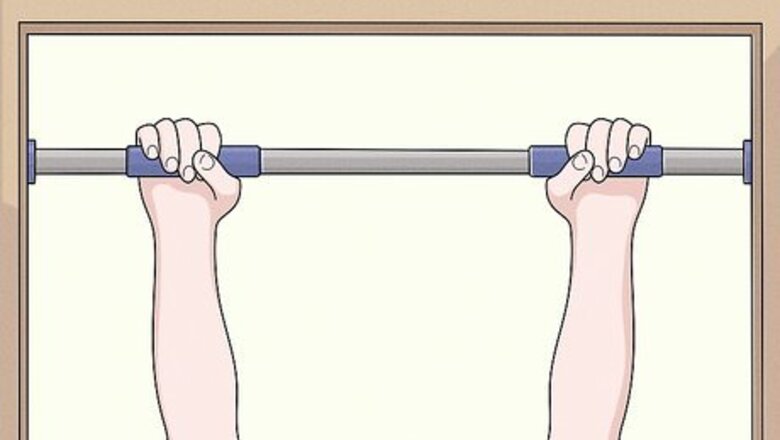
views
- Pull up bars make it easy to stretch muscles in your lower back that are typically very hard to reach with traditional stretches.
- You can get a really solid stretch just by hanging from the bar in a comfortable position for 10-30 seconds.
- Crossing your legs with your feet on the ground while you hang from the bar is a great way to stretch your lats, obliques, and spinal erectors.
Performing a Basic Hanging Decompression
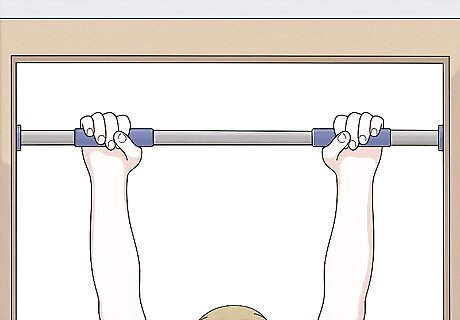
Reach straight overhead and grab the bar with both hands. Keep your arms shoulder-width apart or just slightly wider. To ensure a stronger connection with the bar, hook your fingers over the top of the bar rather than trying to cup it with your palms. Take a moment to confirm that your grip is nice and secure before you continue. You can either complete your grip by tucking your thumbs under like you’re making a fist or leave them out to the sides of your index fingers. Go with whichever position feels more natural for you. It may be a good idea to pull on a pair of gloves to protect your hands if the bar or surface you’re using is rough, rusted, or full of splinters. Some people arrange their thumb next to their fingers on the far. That's no good—it's much better to hold onto the bar with a full grip rather than using only 4 fingers.
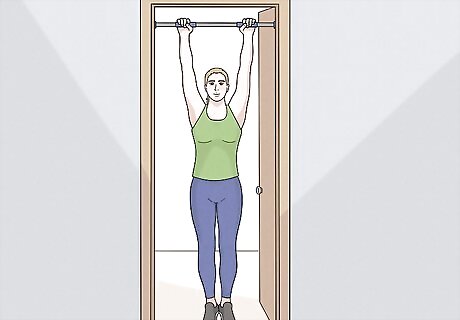
Lower your weight gradually until you’re in a full hang. Start by moving your center of gravity downwards to put some tension into your arms, which should be completely straight. Then, when you’re ready, continue sinking little by little until all or most of your bodyweight is supported by your arms. If you need to, you can let your toes or feet rest on the ground for some added assistance. Don’t drop into the hang too suddenly. Doing so could give you an unpleasant jolt or even put you at risk of injuring one or both shoulders.
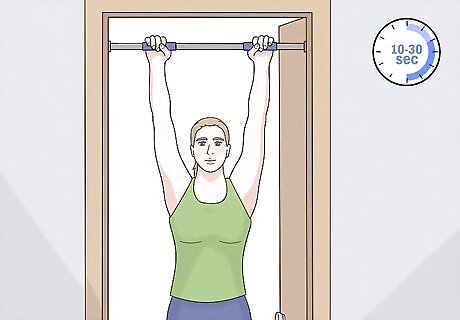
Hang in a relaxed position for 10-30 seconds. This should be enough time to elongate your spine and allow your individual vertebrae to decompress without totally exhausting you. While you’re hanging, focus on releasing any tightness you might be holding in your core. It may take a few seconds to really loosen up, but once you do, you’ll begin to feel relief immediately. Face forward and square your hips to make sure your spine stays in alignment. Your back should form a perfectly straight line throughout the stretch. If you don’t have a good way to time yourself, just count off 5-10 slow, deep breaths while concentrating on softening your midsection. As your strength improves, you can start increasing your hang time for a more thorough stretch.Warning: Be sure to keep the muscles in your arms and upper back engaged to prevent the weight of your body from putting undue strain on your shoulder joints.
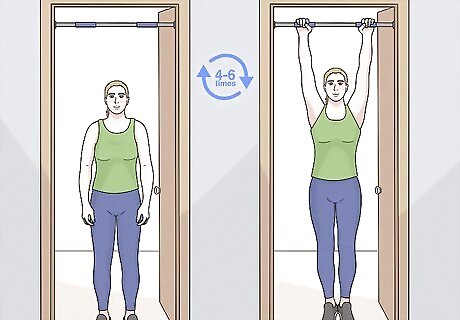
Repeat the exercise 4-6 times with a one-minute break in between each round. An extended rest period will give your arm muscles a chance to recover prior to the next interval. After a few rounds, you should be able to feel a significant improvement in both your upper and lower back. Feel free to perform this exercise 2-3 times throughout the day, or as often as you feel like you need to. There's evidence to suggest that spinal decompression may help to alleviate mild-to-moderate lower back pain and enhance overall mobility.
Adding a Twist for a Deeper Stretch
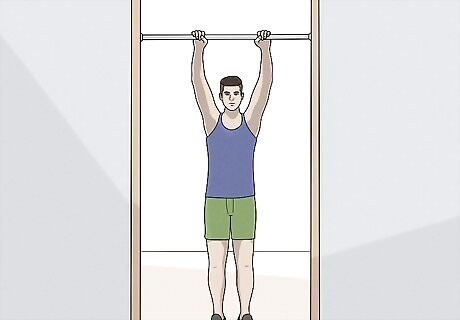
Find a bar low enough to let you keep your toes on the ground while you hang. You’ll need to hold the twist a little longer than you did the normal hang in order to make it as effective as possible. For this reason, it’s important to make sure that the bar you’re using allows you to remain in contact with the floor so you can use your legs to bear a portion of your weight. If you’re at the gym, slide an aerobic step or a set of risers or yoga blocks under your feet to elevate yourself. Not only will it be much harder for you to maintain the twist in a full hang, but your arms will also be much more likely to fatigue faster, forcing you to drop before you get the full benefit of the stretch.
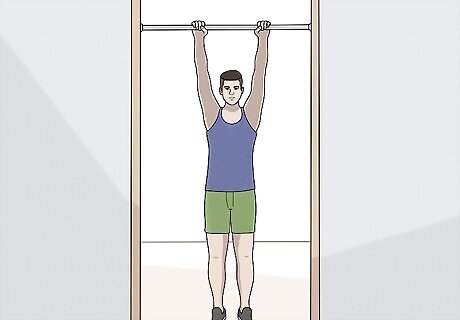
Relax your body beneath your shoulders to initiate the hang. When you’re ready, straighten your arms and bend at the hips and knees until your arms are supporting 60-70% of your weight. You should feel firmly rooted but still be able to move your feet easily. Remember to keep your upper arm, shoulder, and back muscles engaged to avoid stressing your shoulder joints.
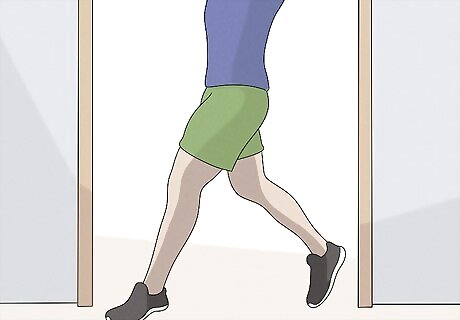
Cross one leg in front of the other and rotate your trunk as far as you can. Swivel your lower body so that one of your legs is in front of you and the other is behind you. Set your legs down about 2–3 feet (0.61–0.91 m) apart and stay poised on the balls of your feet or your tip-toes to minimize your contact with the ground. If you’re especially flexible, aim to get your legs 45-degree angle with your torso to intensify the stretch. Adjusting your lower body could make you feel slightly unsteady, so be careful not to lose your grip on the bar.
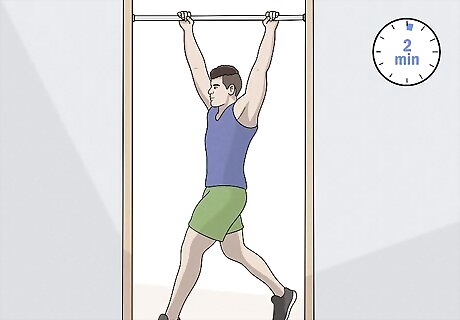
Hold the twist for up to 2 minutes. If it’s your first time doing a hanging twist, start with 5-10 seconds and work your way up from there. Your lower back is full of large muscles that play an important role in stabilizing your body, like the lats, internal obliques, gluteus medius, and spinal erectors, so the longer you hold the stretch, the more you’ll get out of it. Don’t forget to keep up a natural breathing pattern the entire time you’re locked into the stretch. If your arms start to tire out before you reach your targeted time, simply shift more of your weight to your legs.
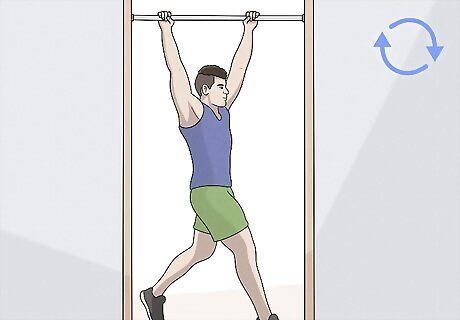
Switch your stance and complete the stretch on the opposite side. Once you’re done stretching your first side, swivel your hips over the other way, plant your feet, and reset your timer. Try to hold the stretch for the same length of time on your second side. Afterwards, your back should feel rejuvenated and ready to go! You can repeat this stretch up to 2-3 times per side, if you like. You may not feel the need to, however, if you opted to hold it for longer than about half a minute on each side. This can also make an excellent mobility drill to add to your warm up routine.Tip: For more of a challenge, you can even turn the hanging twist into an active stretch by keeping your legs together and tucking them up first to one side, then the other.



















Comments
0 comment